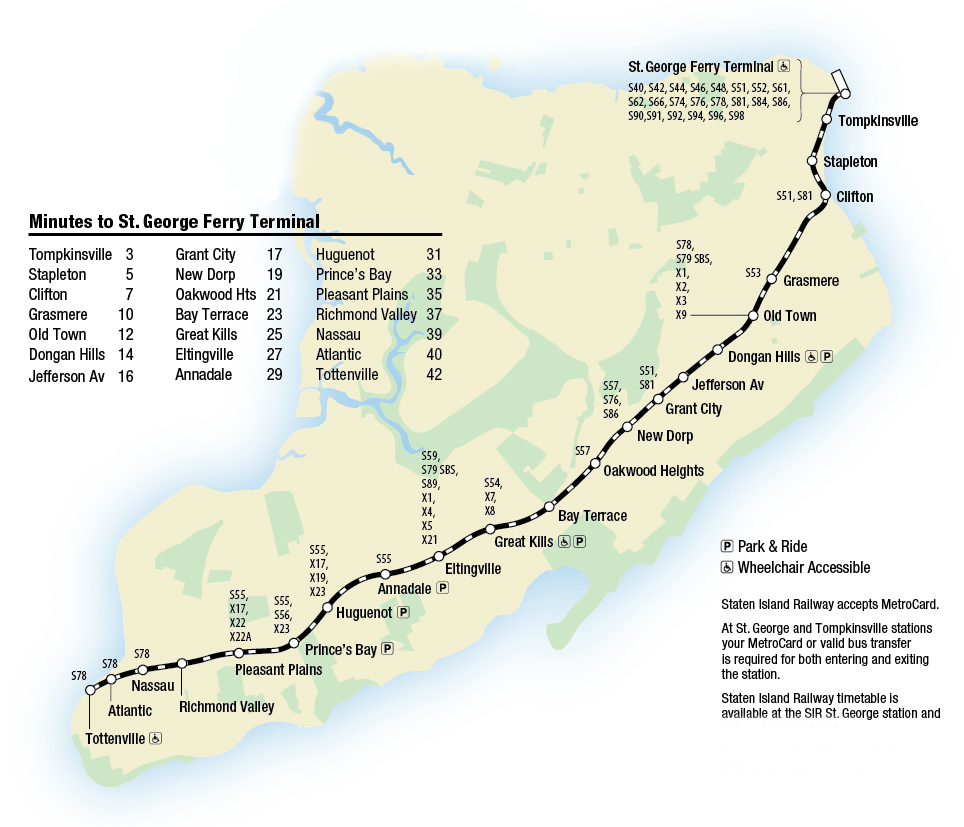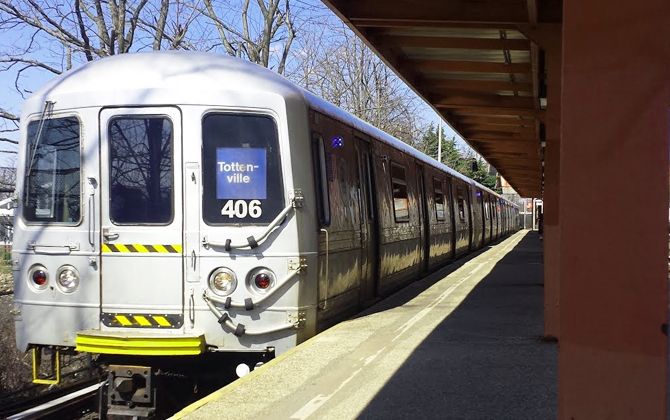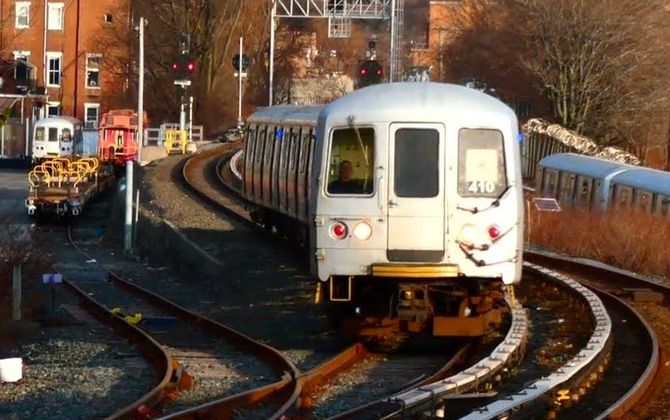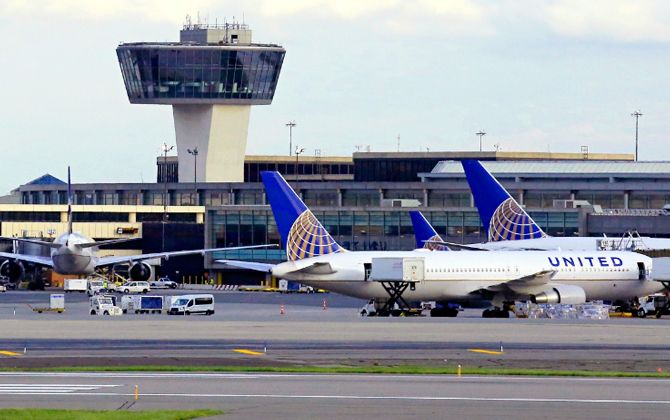The Staten Island Railway (SIR) is a 14-mile (22.5 km) rapid transit line serving Staten Island, New York City. Operated by the MTA, it runs 24/7 between St. George, located at the Staten Island Ferry terminal, and Tottenville on the island’s southern tip.
SIR is the only rail line on Staten Island. Although it is not physically connected to the NYC Subway, it is fully integrated into the transit system. Riders can transfer for free to subways and buses. Most commuters take the St. George Ferry to Manhattan, with the railway terminating directly inside the ferry terminal for a seamless connection.
In 2024, SIR carried about 4.7 million riders, averaging around 19,300 on weekdays. This makes it a key part of Staten Island’s transit network.
Map of Staten Island Railway
The 2026 Staten Island Railway (SIR) map shows a single line running along the island’s eastern shore, from St. George in the north to Tottenville in the south. All 21 stations are located on this one continuous route.
St. George terminal is a major hub, connecting the railway with the Staten Island Ferry and multiple bus routes. From there, trains run south through neighborhoods such as Tompkinsville, Clifton, Great Kills, and Prince’s Bay, before reaching Tottenville near Raritan Bay.
Map of Staten Island Railway showing different lines. Click on the map to enlarge it or download the taten Island Railway map in PDF format.
Lines and Stations
The Staten Island Railway (SIR) operates a single Main Line without branches. Below is the full list of active stations from north to south. All trains run on this one continuous route.
- St. George – Northern terminal inside the ferry complex. Direct transfer to the Staten Island Ferry. Major bus hub and main gateway to Manhattan.
- Tompkinsville – Just south of St. George. Also has fare control entry and exit.
- Stapleton – Serves the Stapleton neighborhood and waterfront.
- Clifton – Located near the Clifton maintenance shops. Short platforms (about 3 cars on the northbound side).
- Grasmere – Serves Grasmere. Transfer available to the S53 bus to Bay Ridge, Brooklyn (via the Verrazzano Bridge to the R subway).
- Old Town – Serves the Old Town neighborhood.
- Dongan Hills – ADA-accessible station.
- Jefferson Avenue – Local residential stop.
- Grant City – Serves the Grant City area.
- New Dorp – ADA-accessible station near New Dorp Lane shopping district.
- Oakwood Heights – Serves the Oakwood neighborhood.
- Bay Terrace – Serves the Bay Terrace community.
- Great Kills – ADA-accessible with a park & ride lot. Close to Great Kills Park, a large coastal park.
- Eltingville – Near Eltingville Transit Center, a major transfer point for bus routes across Staten Island and to Manhattan.
- Annadale – Serves the Annadale neighborhood.
- Huguenot – Station with park & ride. Scheduled for an ADA upgrade in the capital program.
- Prince’s Bay – Serves Prince’s Bay. Short walk to Wolfe’s Pond Park with beach and nature preserve.
- Pleasant Plains – Serves Pleasant Plains. Near Mount Loretto Unique Area nature reserve.
- Richmond Valley – Small station with partial platforms. Former freight junction site.
- Arthur Kill – Opened January 21, 2017, replacing the Atlantic and Nassau stations. Features a 150-space parking lot and is ADA-accessible.
- Tottenville – Southern terminal in Tottenville. ADA-accessible. Historically connected by ferry to Perth Amboy, NJ. Close to Conference House Park at the island’s southern tip.
All trains run between St. George and Tottenville. During peak hours, some express trains skip stops to shorten trips. For example, in the evening rush, certain trains run non-stop from St. George to Great Kills. Most service, however, is local and stops at all stations.
Timetable & Operating Hours
The Staten Island Railway (SIR) runs 24 hours a day, 7 days a week, all year round. It is one of the few rail systems in the U.S. with continuous service. Trains run less often at night, but service never stops.
Frequency
- Peak Hours (weekday rush): Every 15–20 minutes. At the busiest times, intervals shorten to 10–12 minutes, with extra trains added to meet arriving ferries.
- Midday & Evening: About every 20 minutes. In late evening, trains usually run every 30 minutes.
- Late Night (midnight–5 AM): Every 30 minutes, matched to the Staten Island Ferry’s half-hourly schedule.
Most trains are timed to meet the Staten Island Ferry at St. George. This ensures passengers can connect to or from Manhattan without long waits. For example, at night when ferries run every 30 minutes, an SIR train is usually waiting at St. George within minutes of ferry arrival.
On holidays, SIR often runs a Saturday or Sunday schedule with fewer trains. On the afternoon before major holidays, extra “getaway” trains may run to handle early commuters. Service is always at least every 30 minutes, even on weekends and holidays.
Fares on the SIR
Base Fare
The base fare is $2.90 USD, the same as the NYC Subway and local buses.
You can pay with a MetroCard or OMNY contactless system. St. George and Tompkinsville have turnstiles with both options. MetroCards are being phased out by 2026–2026, but as of now both are accepted.
Fares are only charged at St. George and Tompkinsville. At all other stations, rides are free. This makes SIR free for most local trips within Staten Island. Originally, conductors collected fares on trains, but since 1997, the MetroCard system has limited fare collection to turnstiles. Tompkinsville got turnstiles in 2010 to prevent fare evasion from riders walking to St. George.
SIR is part of the subway system. A paid fare includes a free transfer to subways or buses within two hours. For example, if you enter SIR at St. George after arriving by ferry, you are not charged again. However, note that Pay-Per-Ride MetroCards allow only one free transfer, while Unlimited MetroCards and OMNY fare-capping cover multiple transfers.
Reduced Fares
Seniors (65+) and riders with qualifying disabilities pay $1.45. Up to three children under 44 inches (112 cm) tall ride free with a paying adult. Infants under 2 always ride free.
Unlimited Passes and Fare-Capping
Unlimited MetroCards are valid on SIR. With OMNY, fares cap after 12 rides in a week, meaning further rides are free. This matches the 7-Day Unlimited pass, capping weekly fares at $34.
Tickets are not sold on trains. Riders must swipe or tap at turnstiles at St. George or Tompkinsville. To exit St. George, a MetroCard or OMNY tap is required. Machines are available in the terminal for those without a card.
Connections
Although Staten Island’s rail line is separate from the subway network, the Staten Island Railway (SIR) connects with several key transit modes.
Staten Island Ferry at St. George. At its northern end, SIR connects directly to the Staten Island Ferry inside the St. George Terminal. The ferry is free and runs every 15–30 minutes, 24/7, to Manhattan’s Whitehall Terminal. The trip takes about 25 minutes across New York Harbor. SIR train schedules are coordinated with ferry arrivals and departures, minimizing wait times. For most riders, this ferry link is the main connection to Manhattan, effectively extending the SIR journey.
MTA Bus Connections. Every SIR station is served by NYC Transit buses. At St. George, riders can connect to numerous local routes across Staten Island and to SIM express buses to Manhattan. Express routes such as SIM1 and SIM3 link Staten Island to Midtown and Downtown Manhattan. All buses accept MetroCard and OMNY. Transfers from SIR to local or express buses at St. George are free within the standard transfer window.
Brooklyn & Subway Connections. While no subway lines run to Staten Island, riders can connect via bus. From Grasmere station, the S53 bus crosses the Verrazzano-Narrows Bridge to Bay Ridge, Brooklyn, where it meets the R subway line. From Eltingville Transit Center, the S79 Select Bus Service (SBS) also runs to Bay Ridge-86th Street station, providing another subway connection. These routes make travel between Staten Island and Brooklyn possible using the standard one-fare transfer system.
New Jersey Connections. The S89 Limited bus links Eltingville to Bayonne, NJ, via the Bayonne Bridge. It terminates at the 34th Street Hudson-Bergen Light Rail (HBLR) station, where riders can continue to downtown Jersey City or connect to PATH trains. The S89 operates on weekdays during rush hours only and charges the standard fare of $2.90. It is the only non-express NYC Transit bus route that leaves New York City.
Eltingville Transit Center. A short walk from Eltingville station, this hub serves local buses such as the S59 and S79 SBS, as well as Manhattan express buses. Many South Shore commuters park here and continue by SIR or express bus. While not an enclosed transfer, it is an important link for multi-modal trips.
Other Transfers. Several SIR stations connect with useful bus routes. For example, Great Kills station is near the S74/S84 route to the Staten Island Mall and Tottenville. New Dorp station is close to Hylan Boulevard, where S76/S86 buses run. Tottenville station connects with the S59 and S78, serving South Shore communities. All Staten Island buses and SIR are in one fare zone, so MetroCard or OMNY transfers are free in one direction.
Airport Connections
Staten Island has no airports of its own but is close to Newark Liberty International (EWR) and within reach of JFK and LaGuardia (LGA) in Queens.
Newark Liberty International Airport (EWR)
Newark Airport is the closest, about 13 miles (21 km) west of St. George. By car, it takes 25–30 minutes in good traffic. Taxi fares range from $45–$55, with trips averaging about 24 minutes. By public transit, the trip is longer and requires multiple transfers: ferry to Manhattan, PATH train to Newark Penn Station, then NJ Transit bus #62 to the airport. This costs about $7–$10 but takes around 2 hours. Many travelers prefer a car service for convenience. Although planners have proposed a West Shore rail line to Newark Airport, no direct link exists as of 2026.
John F. Kennedy International Airport (JFK)
JFK is about 25–30 miles (40–48 km) east of Staten Island. Driving takes 45–60 minutes but often longer in heavy traffic. By transit, the trip usually involves the ferry to Manhattan, the subway (E, A, or others), and then the AirTrain from Jamaica or Howard Beach to the terminals. The combined cost is $2.90 for subway fare plus $8 for AirTrain. Travel time is typically 2–2.5 hours. Many riders choose taxis or rideshares despite the high cost ($80+ plus tolls) because it saves time and effort.
LaGuardia Airport (LGA)
LaGuardia is 24–26 miles (40–42 km) from Staten Island. Driving takes 40–60 minutes. Public transit requires the ferry plus subway and bus connections. Common routes include ferry to Manhattan, subway to 125th Street or Astoria, and the M60 SBS or Q70 LaGuardia Link bus. Transit takes 2–2.5 hours and can be difficult with luggage. Taxi fares are typically $60–$80 depending on traffic.
Private shuttle and car services operate between Staten Island and airports. Fixed rates may be around $120 for a sedan to Newark, slightly higher for JFK or LGA. Services vary, so it is best to pre-book, especially for early flights.
Regulations
When using the Staten Island Railway (SIR), passengers must follow the MTA Rules of Conduct that apply across the transit system. Key regulations include:
- Bicycles are allowed, with weekday restrictions during rush hours: no bikes on St. George-bound trains from 6–9 AM, or Tottenville-bound trains from 4–7 PM. At all other times, bikes are permitted. Cyclists should stay in designated areas near the ends of cars, hold their bikes securely, and avoid blocking doors. Folding bikes are allowed at all times.
- Strollers are permitted. Folding them during busy periods is recommended but not required. Parents with open strollers should stand near doors where space is larger. Shopping carts and luggage are allowed but should not block aisles or doors.
- Pets must be in carriers or containers, except for service animals.
- Smoking and vaping are prohibited on trains, stations, and MTA property. Alcohol consumption is also banned.
- Priority seating must be yielded to seniors and riders with disabilities. Accessible stations, such as St. George and Great Kills, have marked boarding areas for wheelchair users.
- Non-commercial photography is allowed for personal use, provided no tripods, lights, or restricted areas are involved. Commercial filming requires an MTA permit.
- Walking on or crossing the tracks is forbidden. Always use overpasses or underpasses where provided. Do not attempt to board once train doors begin closing. Fare evasion carries a $100 fine.
Tourist Attractions
Staten Island has a range of sights reachable with SIR plus short bus rides or walks, listed roughly north (St. George) to south (Tottenville).
- St. George & Ferry area: Right by the terminal: Empire Outlets, Staten Island Museum (in/near the terminal), National Lighthouse Museum, St. George Theatre, and waterfront promenade views of New York Harbor and Lower Manhattan.
- Tompkinsville & Stapleton: Tompkinsville offers Sri Lankan restaurants and markets along Victory Blvd. Stapleton’s waterfront (URBY) has cafés and a small park; the historic district shows 19th-century Staten Island.
- Snug Harbor Cultural Center & Botanical Garden: From St. George, take the S40/S44 bus to a campus of museums, galleries, and gardens (including the Chinese Scholar’s Garden). A quick ride from the ferry/SIR terminal.
- South Beach & FDR Boardwalk: Reach via S51 bus from Old Town or Grasmere. The boardwalk spans 2.5 miles (4.0 km) with beach access, a fishing pier, and Verrazzano-Narrows Bridge views.
- Historic Richmond Town: Open-air village museum with preserved buildings and living-history programs. From Oakwood Heights or Bay Terrace, take the S74 bus. Plan ahead; it’s a bit off the rail line.
- Great Kills Park & Marina: Part of Gateway National Recreation Area. From Great Kills station, it’s about 1 mile (1.6 km) to the park entrance (or take the S78). Expect beaches, trails, birding, and a marina.
- Wolfe’s Pond Park: Near Prince’s Bay station (Seguine Ave), about a 15-minute walk to Raritan Bay beaches, woods, ponds, picnic areas, and mountain-bike trails.
- Conference House Park (Tottenville): From Tottenville station, a 10-minute walk leads to the 1680 Conference House (museum, seasonal tours) and bayside paths with views toward New Jersey.
- Mount Loretto Unique Area: Short ride from Pleasant Plains to coastal bluffs, wetlands, and meadows; popular for photography and quiet hikes.
- Staten Island Zoo (West Brighton): From St. George, take S48/S46 buses to a compact, family-friendly zoo known for reptiles; pair with nearby Clove Lakes Park.
Future Plans
Staten Island Railway (SIR) is a single-line system, but several projects and proposals aim to improve service and borough-wide transit as of 2026.
Modern train fleet: New R211S cars replaced the aging R44s. The first train entered service in October 2024, and by September 2026 all 75 cars were delivered. The R211S fleet brings brighter lighting, clearer announcements, digital displays, and accessible areas.
Station accessibility & upgrades: The 2020–2024 Capital Program advances ADA work at Huguenot and Clifton (planning underway). More stations are targeted for future accessibility. Ongoing improvements include structural rehab, better lighting and CCTV, real-time arrival displays, and potential expansion of park-and-ride lots where demand is high.
North Shore BRT: The former North Shore rail right-of-way will be reactivated as a Bus Rapid Transit corridor from St. George toward the West Shore with limited stops, dedicated lanes, and station-style platforms. The Final Environmental Impact Statement was issued in January 2024; planning continues with service targeted for the late 2020s, pending funding.
West Shore transit: Light rail and BRT options have been studied for the growing West Shore. A rail link to New Jersey (e.g., to Newark Airport or Hudson-Bergen Light Rail) has been discussed but is unfunded. A lower-cost BRT remains under consideration; no construction is programmed as of 2026.
Direct subway connection: A tunnel to Brooklyn (reviving the 1920s plan) resurfaces periodically, but no active project is in planning due to cost and logistics. For now, improvements focus on ferry and BRT links.
Service and signal concepts: If ridership grows, midday headways could return to 20 minutes. A future move to CBTC is possible but not a near-term priority. Park-and-ride expansion and transit-oriented development near stations (especially along Bay Street/North Shore) are being encouraged.




